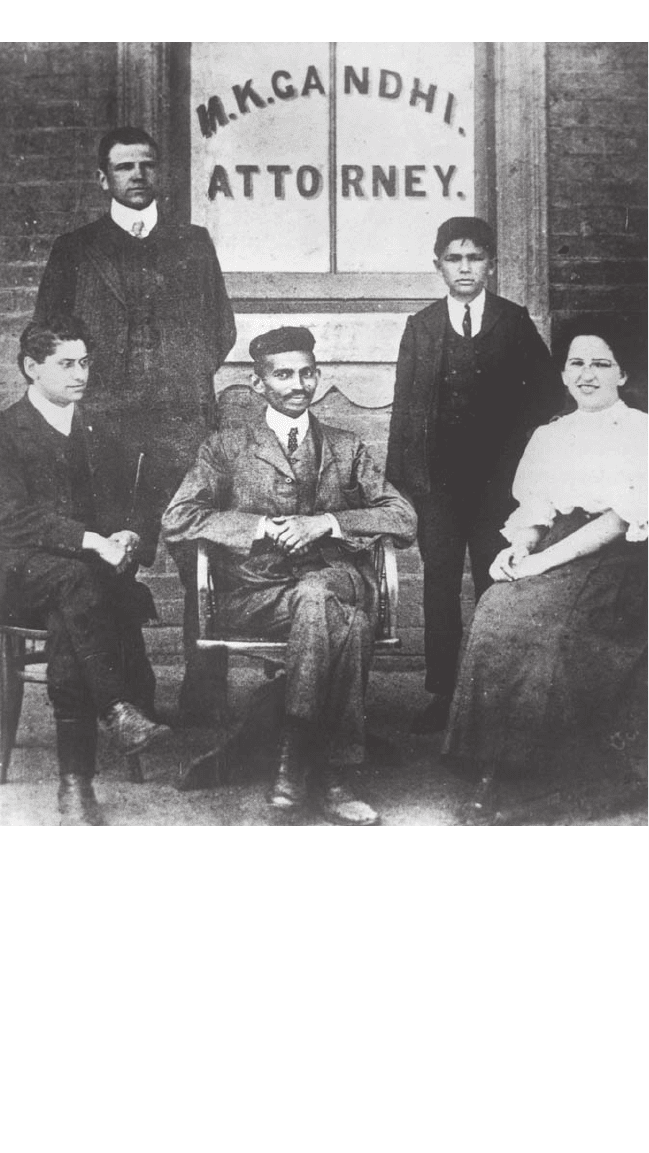Walsh J.E. A Brief History of India
Подождите немного. Документ загружается.


A BRIEF HISTORY OF INDIA
182
Kshatriyas, the Banias, the Sudras [sic], the Sikhs, the Bengalis, the
Madrasis, and the Peshawaris” could never become a single homoge-
neous nation (De Bary 1958, 747).
Nevertheless, by 1887, largely due to the efforts of Allan Octavian
Hume, Muslim attendance at Congress sessions had risen to almost
14 percent of the delegates. But after 1893, as communal confl ict esca-
lated in north India, revivalist Hindu groups demanded cow protection
and the Hindi language, and political festivals in Maharashtra defi ned
Hindus as a separate communal and political entity, Muslim willingness
to support a Hindu majoritarian institution such as the Indian National
Congress declined. Muslim participation in Congress dropped to just
over 7 percent of the delegates for the years from 1893 to 1905. Protests
against the partition of Bengal only alienated Muslim leaders further as
many east Bengali Muslim leaders could see great benefi ts for them-
selves and their communities in a separate Muslim majority province.
In 1906 at the height of partition confl icts, as rumors circulated of
possible new British constitutional reforms, a deputation of 35 elite
Muslims, most from landed United Province families, met the viceroy,
Gilbert John Elliot-Murray-Kynymound, Lord Minto (1845–1914), at
Simla. Their leader was Aga Khan III (1877–1957), the spiritual head of
the Nazari Ismaili Muslim community and one of the wealthiest men in
India. If there were to be reforms involving elections to the Legislative
Councils, the deputation told Minto, they must include separate elec-
torates for Muslims. (Separate electorates gave a community a special
electoral category in which only that community could vote.) Only
separate electorates could guarantee Muslims a voice among elected
representatives, the delegates insisted. As the Hindus were the majority,
they would vote only Hindus into offi ce. Neither Muslim interests nor
the Indian Muslim population, the Simla delegation insisted, could be
adequately represented by non-Muslim candidates.
Many scholars have pointed to the 1906 Simla conference as the
beginning of an explicit British policy of “divide and rule” in India. By
encouraging Muslims to see themselves as a separate political entity—
one defi ned in opposition to Congress—the British hoped to prolong
British rule. In 1906 the viceroy assured the Simla deputation that
Muslim interests would be considered in any new reforms. Encouraged
by this support, the Simla delegates and an additional 35 Muslims from
all provinces in India met at Dacca several months later and founded
the All-India Muslim League. Only Muslims could become members
of this league, whose specifi c purpose was defi ned as the advancement
of Indian Muslims’ political rights. Modeling themselves on the Indian
001-334_BH India.indd 182 11/16/10 12:42 PM

183
TOWARD FREEDOM
National Congress, the Muslim League met annually over the Christmas
holidays. With its inception Muslims had a nationwide political organi-
zation that paralleled that of the “Hindu-dominated” Congress.
The Surat Split
The credibility of Congress moderates was badly damaged by their inac-
tion during the swadeshi movement. While Gokhale (Congress presi-
dent in 1905) initially supported the boycott, he and other moderates
withdrew their support within a month from fear of government repri-
sals. Instead the moderates hoped that the new Liberal government in
Britain, and especially its pro-Indian secretary of state, John Morley,
would withdraw the partition.
In 1906, however, as protests continued, the moderates maintained
control over the Congress session only by endorsing (if somewhat
belatedly) the swadeshi movement. Even the 81-year-old Dadabhai
Naoroji now declared that swaraj (self-rule) was the goal of Congress.
In 1907 at Surat, however, the extremist faction was again frustrated in
their attempt to elect Lajpat Rai as Congress president. Someone threw
a shoe at the moderate president-elect as he attempted to speak, and the
session dissolved in chaos. The moderates walked out of the meetings
and in the aftermath of the Surat debacle effectively shut the extremist
faction out of Congress.
In 1907 the Liberal British government and its India appointees esca-
lated their efforts to shut down the swadeshi movement. Police attacked
and arrested student picketers. Offi cials threatened colleges supporting
the protests with the withdrawal of their grants, scholarships, and affi li-
ations. Public meetings, assemblies, and strikes were banned; swadeshi
committees became illegal; even schoolchildren were prohibited from
singing “Bande Mataram.” Extremist leaders were arrested, charged
with sedition, or exiled. In 1907 Lajpat Rai was deported without
trial to Mandalay in Burma. In 1908 the Bengali extremist Aurobindo
Ghosh, who had led Bengali protests through his English-language
weekly, Bande Mataram, was jailed and charged with sedition. (Two
years later, in 1910, fearing further imprisonment Ghosh would fl ee
Calcutta for the French colony of Pondicherry where for 40 years he
would head a religious ashram.) In Pune the government arrested Tilak
in 1908, charging him with sedition on the basis of editorials sup-
porting Bengali terrorism. Tilak’s sentence to six years’ imprisonment
prompted a violent general strike in Bombay that left 16 people dead.
The arrest and imprisonment of extremist leaders gave the moderates
001-334_BH India.indd 183 11/16/10 12:42 PM

A BRIEF HISTORY OF INDIA
184
full control over Congress but no access to the substantial Indian public
now in sympathy with extremist aims.
Morley-Minto Reforms
Long-rumored constitutional reform became offi cial in 1909 with the
announcement of the Morley-Minto reforms, offi cially known as the
Indian Councils Act of 1909. Although written by Liberal offi cials
in London, the act was announced by the viceroy, Lord Minto, in
Calcutta to give a great impression of government unity. The reforms
put additional Indian members on the Legislative Councils, both at
the center and in the provinces, and more important, they changed
the method of selection for the councils to “direct elections” from the
various constituencies—municipalities, district boards, landowning
groups, universities, and so forth—from which recommendations for
the councils had come since 1892. The act also established separate
electorates for Muslims: six within the landlord constituencies of the
Imperial Legislative Council and others in the provincial councils. The
Imperial Legislative Council was not a voting body: Its members only
commented on government policies when offi cial (British) members
of the council introduced them for discussion. The 1909 act, however,
gave council members greater freedom to ask questions during such
discussions.
Morley himself, the Liberal secretary of state for India, denied that
the reforms would in any way lead to self-government in India. In
the context of Indian nationalist politics where extremist calls for
swaraj were now common, the Morley-Minto reforms offered little.
But to moderates, who had long interested themselves in elections and
appointments, the reforms were attractive.
In 1911, two years after the Morley-Minto reforms became law, the
British celebrated a great durbar (the Persian name for a grand court
occasion) in Delhi to celebrate the coronation of the British king
George V. At a spectacle calculated to demonstrate the permanence of
British rule, the British made their real concession to the power of the
swadeshi movement. They revoked the 1905 partition and reunited
Bengali-speaking Indians with a smaller, new province of Bengal. (At
the same time Bihar and Orissa became separate provinces and Assam
a separate territory.) At the same durbar, however, the British also
took their revenge on Bengal and Bengalis: The viceroy announced the
transfer of the capital to Delhi. The government would now be closer
to the summer Simla capital and further from the troublesome political
001-334_BH India.indd 184 11/16/10 12:42 PM

185
TOWARD FREEDOM
activities of Bengali babus (gentlemen). “New Delhi,” the British sec-
tion of Delhi, would be designed by the architects Edward Lutyens and
Herbert Baker.
Bengal’s reunifi cation embittered Indian Muslims without satisfying
Indian nationalists. “No bomb, no boons” was one Muslim slogan in
Dacca and eastern Bengal (Wolpert 1989, 286). At the 1912 ceremonies
to open the new capital, the viceroy, Charles Hardinge (1858–1944),
was almost killed by a bomb. His assailants were never found, and ter-
rorist violence continued in the Punjab. In 1913 the Muslim League
moved signifi cantly away from its former loyalist position when it
adopted self-government as its goal.
World War I
When Great Britain declared war on Germany on August 4, 1914, the
Indian viceroy, Lord Hardinge, was at once informed that India was
also at war. Indian nationalists of all factions supported Great Britain
in World War I, assuming that support for Britain in a time of crisis
would translate later into signifi cant self-government concessions.
Tilak, released from prison in 1914, raised funds and encouraged enlist-
ment in the army. The lawyer and nationalist Mohandas K. Gandhi
(1869–1948), who was returning to India from South Africa by way of
England, also urged support for the war.
During World War I the Indian army expanded to more than 1.2 mil-
lion men. Indian casualties were high. Within two months of the war’s
start 7,000 Indian troops were listed as dead, wounded, or missing in
action in Europe. Fighting in 1916 in the Persian Gulf, thousands of
Indian soldiers died from lack of adequate food, clothing, mosquito
netting, and medicines. By 1918 more than 1 million Indians had
served overseas, more than 150,000 had been wounded in battle, and
more than 36,000 had died.
Within India the war brought increased income taxes, import duties,
and prices. From 1916 to 1918 Indian revenues increased approxi-
mately 10 to 15 percent each year. Increased amounts of Punjabi wheat
were shipped to Great Britain and its Allies during the war, with the
result that in 1918, when the monsoon failed, food shortages increased
and food prices rose sharply. The war also cut off India from its second
largest export market; prewar Indian exports to Germany and Austria-
Hungary in 1914 had a value of £24 million. Products from the Central
Powers (the countries allied with Germany) were also among India’s
most popular imports. The war was a boon, however, to indigenous
001-334_BH India.indd 185 11/16/10 12:42 PM

A BRIEF HISTORY OF INDIA
186
Indian industries such as cotton cloth, steel, and iron. In all these
industries production grew more quickly in the absence of European
competition.
Lucknow Pact, 1916
Anticipating possible constitutional concession at the end of the war,
nationalist leaders looked for ways to renew the movement. In 1916
both Annie Besant in Madras and Tilak in Pune founded “home rule
leagues,” organizations that argued for Indian self-government (on the
model of Canada) within the British Empire. Within a few years the
movement had hundreds of chapters and 30,000 members. In 1916 at
a meeting at Lucknow, the newly reunited Indian National Congress
joined with the Muslim League in the Lucknow Pact (otherwise known
as the Congress-League Scheme of Reforms). The joint pact called for
constitutional reforms that would give elected Indian representatives
additional power at the provincial and the central levels. All elections
were to be on the basis of a broad franchise. The principle of separate
electorates for Muslims was accepted, and the percentage of such elec-
torates was specifi ed province by province. Half the seats on the vice-
roy’s Executive Council were to be Indians. India Offi ce expenses were
to be charged to British taxpayers.
New Leaders
Both the reunifi cation of Congress and the Lucknow Pact were
made somewhat easier by the natural passing of an older generation
of nationalist leaders and the rise to prominence of younger ones.
Gokhale and Pherozeshah Mehta died in 1915, Lokamanya Tilak in
1920, and Surendranath Banerjea in 1925. Two younger men appeared
who would dominate Congress throughout the 1920s–40s: Mohammed
Ali Jinnah (1876–1948), a successful Muslim lawyer and Congress poli-
tician, joined the Muslim League in 1913; and Gandhi, already known
in his homeland for leading Indian protests against the British in South
Africa, returned to India in 1915.
Mohammed Ali Jinnah
Jinnah was born and educated in Karachi, the son of a middle-class
merchant of the Muslim Khoja community who had migrated to Sind
from Gujarat. Sent to England for university and law education in
001-334_BH India.indd 186 11/16/10 12:42 PM

187
TOWARD FREEDOM
1892, Jinnah was drawn into nationalist politics during his fi rst year
in London when he worked for the parliamentary election of Dadabhai
Naoroji. Back in India, he rapidly established a successful law practice
in Bombay, became a delegate to the 1906 Congress, and was elected
(under Morley-Minto provisions) to the Imperial Legislative Council
in 1910. Jinnah impressed Indian politicians and British offi cials alike
with his intelligence, his skill in argument, his anglicized habits, and
his fastidious dress and appearance. When the Muslim League declared
its goal to be self-government in 1913, Jinnah joined. He initially hoped
to bring the Muslim League and the Indian National Congress into uni-
fi ed opposition to British rule.
Mohandas K. Gandhi
Gandhi, like Jinnah, was born in western India, in the small Princely
State of Porbandar (now a district in the modern state of Gujarat). His
father served there as dewan (minister) before moving on to another
small state nearby. Also like Jinnah, Gandhi was educated fi rst in India
and then sent in 1887 by his family to study law in London, an experi-
ence that anglicized him, too. When Gandhi returned to India in 1890
he wore British-style frock coats and trousers, insisted that his wife and
children wear shoes and socks, and wanted his family to eat oatmeal
regularly. Unlike Jinnah, however, Gandhi did not succeed as a lawyer,
either in Gujarat or Bombay. After several years of trying to establish
himself in practice there, he accepted a legal assignment with an Indian
Muslim business fi rm in Natal, South Africa.
From 1893 to 1914 Gandhi lived and worked in South Africa. It was
in South Africa that he discovered his avocation as a political organizer
and his religious faith as a modern Hindu. The diverse South African
community was made up of Hindus, Muslims, Parsis, and Christians
who came from regions as different as Gujarat and south India. Gandhi
led this multiethnic, multireligious community in a variety of protests
against British laws that discriminated against Indians. He developed
the nonviolent tactic of satyagraha (literally “truth-fi rmness” or “soul
force”) that he would later use in India. “I had . . . then to choose,” he
would later remember, “between allying myself to violence or fi nding
out some other method of meeting the crisis and stopping the rot, and
it came to me that we should refuse to obey legislation that was degrad-
ing and let them put us in jail if they liked” (Hay 1988, 266). He led
nonviolent campaigns in 1907–08 and 1908–11 and a combined strike
and cross-country march in 1913–14.
001-334_BH India.indd 187 11/16/10 12:42 PM

A BRIEF HISTORY OF INDIA
188
It was also in South Africa that Gandhi developed the religious and
ethical ideas that merged the Western education of his youth with the
beliefs and principles of his family’s Hindu religion. By the age of 37,
Gandhi had simplifi ed his diet according to strict vegetarian rules, had
Mohandas K. Gandhi in South Africa, 1903. Gandhi lived and worked as a lawyer in South
Africa from 1893 until 1914, eventually (by 1907) developing his ideas on nonviolent protest
and on religion. Here he is seated in front of his South African law offi ce with several employ-
ees. The woman is Miss Schlesin, the daughter of Russian immigrants to South Africa, who
worked in Gandhi’s offi ce. To Gandhi’s right is his clerk, H. S. L. Polak.
(photo by Keystone/
Getty Images)
001-334_BH India.indd 188 11/16/10 12:42 PM

189
TOWARD FREEDOM
taken a Hindu vow of celibacy (brahmacharya), and had exchanged
his Western dress for a simpler Indian costume, a dhoti (a long cloth
wrapped around the lower body), shawl, and turban. In South Africa
and later in India Gandhi’s political philosophy would rest equally on
the Jain principle of ahimsa (nonviolence) and on the conviction that
the means by which a political goal was achieved was fully as important
as its end result. In India Gandhi would undertake fasts to the death on
several occasions, a form of personal satyagraha by which he hoped to
win over the hearts of his opponents.
In 1915 when Gandhi returned to India, he was already famous
there. The diversity of the South African Indian community had given
him a broader background and experience than that of most nationalist
leaders with their more limited regional bases. Nevertheless, Gandhi
was not an immediate success in India. His simple dress of dhoti, shawl,
and turban made him seem idiosyncratic to Westernized audiences.
He spoke too softly and tended to lecture his listeners on the need
for Indian self-improvement. His initial speeches to Congress and the
Home Rule League were not well received.
After his return to India, Gandhi made his base in the city of
Ahmedabad, Gujarat, founding there an ashram and traveling by third-
class railway coach throughout British India. In the fi rst years of his
return he organized a satyagraha against indigo planters in Champaran
district in the foothills of the Himalayas, campaigned for a reduction
of land revenues in Kheda district in Gujarat, and fasted to compel his
friends and fi nancial supporters, the industrialist Sarabhai family, to pay
their workers higher wages. These campaigns gained Gandhi visibility
and sympathy within India. But to the more anglicized nationalists he
may still have seemed as incomprehensible as he did to Edwin Montagu
(1879–1924), the British secretary of state for India, who met Gandhi
on a tour in 1917. He “dresses like a coolie,” Montagu wrote in his
diary, “forswears all personal advancement, lives practically on the air,
and is a pure visionary” (Wolpert 2009, 308).
The Amritsar Massacre
The end of World War I brought with it a new offer of constitutional
reforms from the British government, but the reforms themselves were
broadly disappointing to almost all factions of Indian nationalists. The
Montagu-Chelmsford reforms (or the “Montford reforms,” as they are
sometime abbreviated) were promised as a move toward responsible
government. They were announced in 1917 and implemented two
001-334_BH India.indd 189 11/16/10 12:42 PM

A BRIEF HISTORY OF INDIA
190
years later in the Government of India Act of 1919. The Montford
reforms offered Indians “dyarchy” (or dual government) at the pro-
vincial level; under this plan the government transferred responsibility
for some governmental departments—education, public health, public
works, agriculture—to elected Indian ministers, while reserving other
departments—land revenue, justice, police, irrigation, and labor—to
ministers appointed by the British. Indian legislative members would
continue to be elected into these provincial governments through the
various constituencies established in earlier reforms.
From the British perspective the Montford reforms had the advan-
tage of bringing elected Indian offi cials into collaboration with the
existing British Indian government, even as they cut off those same offi -
cials from the more extreme wing of the nationalist movement. From
the nationalist perspective, the reforms ceded little if any real power to
Indians. They gave Indian ministers the responsibility for traditionally
underfunded departments, while giving them no control over or access
to the revenues through which the departments were funded. Congress
leaders split over how to respond. Jinnah proposed rejecting Montford
outright. Tilak and Besant feuded over the wording and extent of their
rejections. The remnants of the old moderate faction considered found-
ing a separate party to allow them to accept the reforms.
But the unity that factions in the Indian National Congress could not
fi nd among themselves, British offi cials created for them. During World
War I the Defense of India Act (1915) had created temporary sedi-
tion laws under which, in certain circumstances, political cases could
be tried without juries and suspects interned without trials. In 1918
when the Rowlatt Committee recommended that these laws become
permanent, the Indian government immediately passed the Rowlatt
Acts, ignoring the unanimous objections of all Indians on the Imperial
Legislative Council. Jinnah resigned his council seat in 1919 when the
acts became law. Gandhi called for a nationwide hartal (strike) to pro-
test them.
When the strikes in Delhi and North India turned into riots and
shooting, Gandhi immediately ended the hartal, calling it a “Himalayan
miscalculation” (Fischer 1983, 179). But in Amritsar, the sacred city of
the Sikhs in the Punjab, the government responded to the city’s hartal
by deporting Congress leaders and prohibiting all public meetings.
On April 13, Brigadier General Reginald Dyer (1864–1927), the com-
mander in charge of the city, heard that a gathering was to take place at
Jallianwalla Bagh (Jallianwalla Garden). Dyer posted his troops at the
entrance to the walled garden where some 10,000 people had already
001-334_BH India.indd 190 11/16/10 12:42 PM

191
TOWARD FREEDOM
gathered. Without warning, he ordered his troops to fi re. A later parlia-
mentary report estimated that 1,650 rounds of ammunition were fi red,
killing 379 people and wounding another 1,200. In the months follow-
ing the Amritsar massacre, Dyer maintained rigid martial law. At one
site where a British woman had been attacked, he ordered Indians who
passed to crawl. Those who refused were to be publicly fl ogged.
Dyer was subsequently forced to resign from the military, and the
Indian Hunter Commission condemned his actions. But in Great
Britain he was a martyr. The pro-imperial House of Lords refused to
censure Dyer, and on his return to England a British newspaper raised
£26,000 for his retirement.
In India, public outrage brought Indians together in opposition to
the British. Rabindranath Tagore, who had been knighted after receiv-
ing the Nobel Prize in literature in 1913, renounced his knighthood.
The 1919 session of Congress was moved to Amritsar. The 38,000
people attending demonstrated that Congress was united as never
before. In the 1920s Gandhi would move nationalism to a new level. By
building up the Congress organization in Indian villages, Gandhi would
make the Congress Party a mass movement.
001-334_BH India.indd 191 11/16/10 12:42 PM
